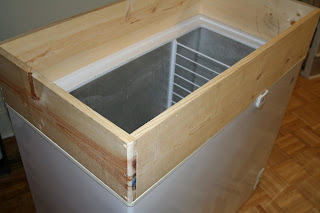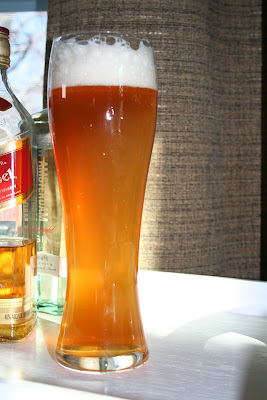I have a new girlfriend. Her name is Warrior, yes, my wife knows. She has a few issues and obviously needs quite a bit of attention, but I'm excited at my new relationship. And my new beer is inspired by her.
She's a 1981 Volkswagen Rabbit or "Caddy" Truck. She has a 1.6L Diesel engine, no turbo, so 56 horsepower. Still the last owner thought it was a big truck so she's got dual chrome stacks, a 3" lift, and emblems that say "Size Matters" and "Turbo" (even though she's naturally aspirated). She's equipped with a 5-speed manual transmission so that mean about 50 miles to the gallon. She's dressed in forest green with orange pin striping.
Now I can't get credit for finding this treasure. My brother Eric helped me find this beauty. His first truck, also a '81 Rabbit came from Colorado. His yellow truck with an orange hood named "Chief" was the first in his fleet. The second truck, Warrior, found him. Along with a third, an '80 Rabbit, and a parts truck. Deciding he had too many projects, he turned one over to me.
I named this truck "Warrior" for a few reasons. One, it plays off the name of my brother's truck, "Chief". It is also the name of one of my favorite types of hops with a high alpha acid content. It is also green so, as a home brewer, it reminded me of hops. It was also a leadership position I help in a group, the Scarlet and Cream, in college.
I was inspired by these diesel trucks to make some dedicated brews, an IPA and a Pale Ale for Chief. Today was my day off so I decided to start with the IPA. This is a strong IPA, it'll be around 8% by volume with plenty of Warrior hop flavor. It has a nice amber color and it had a roasty smell while it was in the mash.
Recipe:
16 lbs. 2-row Barley
2 lbs. Amber Malt
2 oz. Warrior Hops
2 oz. Summit Hops
1 oz. Warrior Hops Dry Hop
.5 oz. Summit Hops Dry Hop
1968 London Ale Yeast
I started my mash at 152 degrees and a stiff mash as well. I let it sit for an hour and then began sparging. I did a 90 minute boil and I started adding my hops at 10 minutes after the first bubbles appeared. I mixed together the Summit and Warrior hops in a bowl, I added .5 oz. of the mixture every 10 minutes. This should give the beer a nice variety of hop bitterness, flavor, and aroma. The dry hopping will also give it some grassy, resin flavor. I can't wait to try this beer.
I did something stupid though, I haven't brewed in a while, and I know that isn't an excuse, but I forgot to sanitize my fermenter. I had just rinsed it out, but there could have been some bad critters in it anyway. I had already pitched my $6 yeast so I decided to just chance it. So we'll just see what happens. Again, cross your fingers...
So it tastes great! The beer turned out fantastic and is a great dedication to the truck. It has a great malty-ness and a great hoppy bitterness. It also has a nice grapefruit citrus flavor. That color came out great too. I think this is my favorite double IPA recipe so far.






























